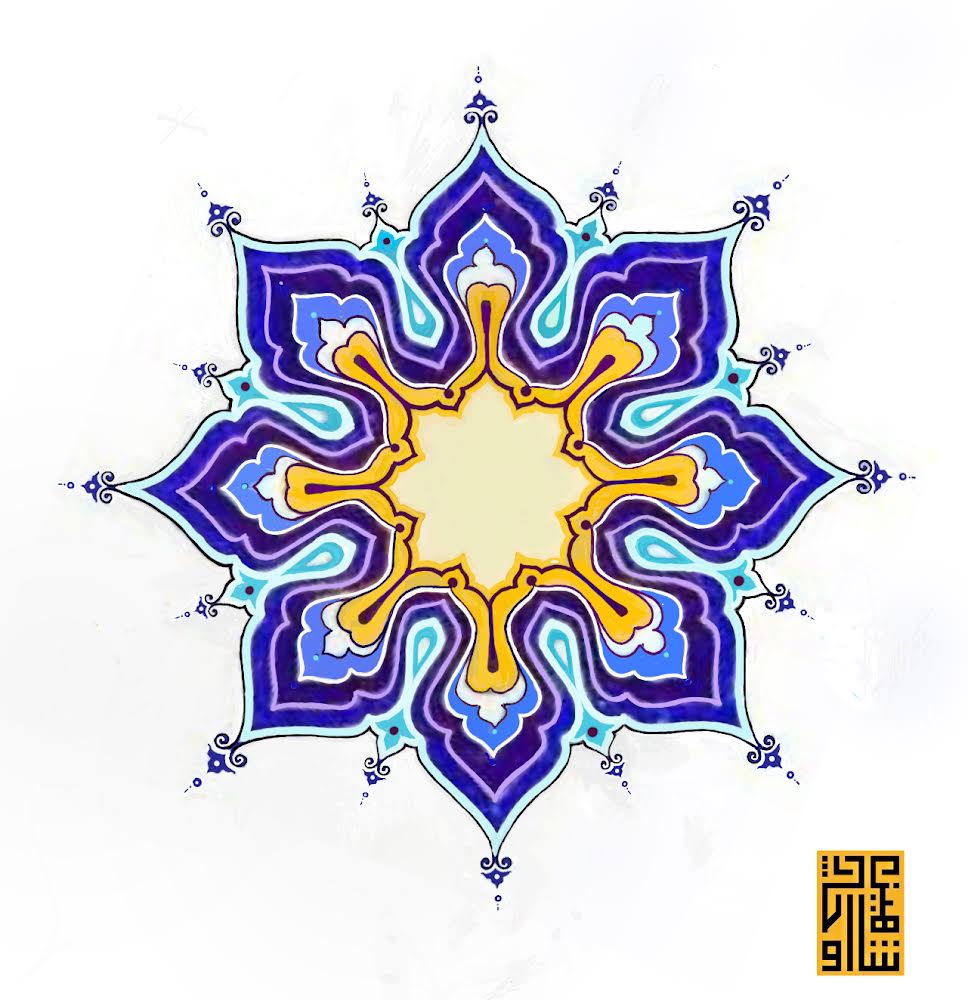I have to write and express my ideas about kufic scripture because I wish to expose my kufic calligraphy compositions published all together; so that, it would be registrated in a book format. Because, being a history professor -my doctoral dissertation was “Arab invasions to Anatolia (640-750 A.D.)- I am also known as a kufi calligrapher, professionally taking orders and composing kufi calligraphy since 1970. My first design “nokta-i suğra” had been published on the cover of a book, Peyami Safa “(Sanat,Edebiyat Tenkit,” Ötüken publishing, Istanbul, 1970.

This nokta design is quoted and published in the article of Nokta-i Suğrâ, in the Encyclopedia of Literature (Edebiyat Ansiklopedisi) published by Dergah.yy. İstanbul, 1991.
I will interprete about kufic scripture, but within the framework of a holistic understanding according to my own philosophy of history; that is, with a multidisciplinary approach, taking into consideration all the different angles of different disciplines. Let me say here that ‘all meaning is an angle’, and there cannot be understanding without a perspective.
Naturally, I will write from a historical perspective about the arabic script and kufic calligraphy; but, because this essay will include my own designs in addition to the historical kufi calligraphy examples, there should be an aesthetical perspective too. On the other hand, because of the special importance of the language and scripture in Islam, kufi scripture could be disputed from the standpoint of theology . ‘Again, it should be discussed from a semantical viewpoint because some linguists believe that language is god-given, it is not created by humans.
When one speaks about kufic scripture, all of these different perspectives seems suitable, even necessary, because according to the islamic belief Qur’an is the word of God and revealed to Muhammed brought by archangel Gebrail; and being revealed in such a way, it is the sacred word of God which is not created by men. ‘The Pen and Tablet are the metaphysical principles to which Islamic theologians ascribe the working out of creation and destiny.’ (A.dab al-mashqJOURNAL)
Indeed, Kufic script is used primarily for writing Qur’an for centuries, but nevertheless, kufic script is seen everywhere from buildings to the instruments and even on the clothes. So the writing calligraphy had been the most formative element of islamic culture, so much so that, it is the most marked and apparent aspect of islamic civilization. From the 7th to 11th for five centuries Kufic calligraphy have been the most prominent aspect of the cultural identity of the Muslim world and it appeared as a civilization of kufic scrupture; and so, quranic verses were visible everyhere from the buildings to the ‘tiraz’ called clothes. The word of God, as if embodied by the Kufic calligraphy, as if it was visible incarnation of “Kelam”(likewise logos concept of Heraclit), embodied and represented by the solemn character of the kufic scripture of Qur’an. It appeared within every aspect of islamic culture, everywhere . This reminds me a verse from the qur’an: ‘Ve lillâhi’l-maşrıku ve’l-mağrib. Fe’eynemâ tuvellû fe-semme vechullah”: : ‘to God belong the East and the West; whithersoever you turn, there is the Face of God.
When I decided to write about my kufi calligraphy and kufic scripture in general, at first I thought that this is a new opportunity to convey all of my ideas again here, perhaps more clearer than my preceding writings, within this illuminating light of the kufic scrupture; but in that case, to explain and discuss so many ideas would be a never ending story which needs large book volumes. At that rate, it would be better for my short term goals to finish this essay in a short time, to write primarily about the art of kufic calligraphy, including all my kufic calligraphy designs in it. Yet it seems necessary to utter some short and jurisdictive sentences of criticism about historical knowledge of scrips, language and human knowledge in general showing the different and narrow angles of different disciplines of understanding. This is why I am going to write a short introduction about language and human knowledge in general before going to delve to the history of Kufi calligraphy.
The History of Arabic Script and Kufic Calligraphy: Development, Influence, and Significance
Introduction
Arabic calligraphy stands as one of the most distinctive and revered art forms in Islamic civilization. What began as a practical means of communication evolved into a sophisticated artistic tradition that has profoundly shaped Islamic visual culture for over fourteen centuries. This comprehensive study explores the rich history of Arabic script and Kufic calligraphy, examining their origins, development, key historical figures, political influences, applications across various media, and their profound significance in Islamic civilization.
The Arabic script, with its flowing curves and distinctive forms, has transcended its utilitarian origins to become a profound expression of faith, culture, and aesthetics. Among its many styles, Kufic calligraphy—with its angular, geometric character—holds a special place as the oldest formalized style of Arabic script, used extensively in early Quranic manuscripts and architectural decoration.
This document traces the journey of Arabic script from its pre-Islamic origins through its development into various calligraphic styles, with a particular focus on Kufic calligraphy. It examines how political and historical forces shaped its evolution, how master calligraphers refined and systematized it, and how it was applied across architecture, textiles, and decorative arts. Finally, it explores the profound religious, cultural, aesthetic, and intellectual significance of Arabic calligraphy in Islamic civilization, both historically and in the contemporary world.
